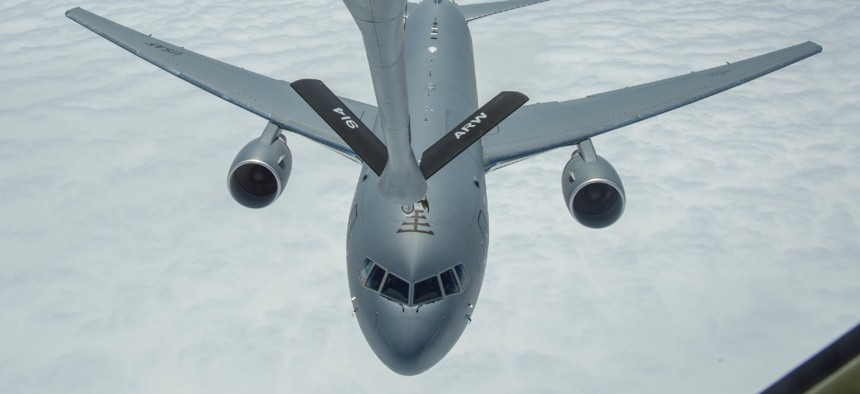
A KC-135 refuels a KC-46 over the Atlantic Ocean. Peter Borys / U.S. Air Force
Air Force Hunts for Ways to Use Not-Quite-Ready Tankers
We’re “making lemonade out of lemons,” Air Mobility Command says.
The U.S. Air Force is considering using its troubled KC-46 tanker for some “limited operations” as it looks for ways to use dozens of aircraft that remain years from battle-readiness.
Ten years to the month since Pentagon leaders chose the Boeing KC-46 over a similar tanker built by European rival Airbus, the plane is still in testing and is expected to be war-ready no earlier than late 2023, thanks to needed improvements in its refueling system.
“As I look over the 10 years, I have to say...right now where we're at in the program is we're making lemonade out of lemons,” Air Force Gen. Jacqueline Van Ovost, the head of Air Mobility Command, said during a Monday Defense Writers Group Zoom meeting.
“We are exploring limited operational capability for the KC-46,” she said.
In addition to refueling tests, the plane has already been used during a command-and-control experiment, aeromedical evacuation and cargo missions. KC-46s have also flown around the world.
The KC-46 is allowed to refuel 10 types of planes, albeit some restrictions. The Air Force plans to certify five additional aircraft in the coming months, Van Ovost said.
The Air Force has ordered 94 of a planned 179 KC-46 tankers. The planes will replace KC-10 Extender tankers — which the Air Force has already begin retiring— and Eisenhower-era KC-135 Stratotankers. Boeing has delivered 42 planes to the Air Force and the Air Force expects to receive two tankers per month for the foreseeable future, Van Ovost said.
The tanker is years behind schedule, thanks to a host of design and development troubles. The contract has hung most of the cost on Boeing, which has lost more than $5 billion on the plane.
Unlike the KC-135 and KC-10 tankers where an airman looks out a window on the back of the plane at the aircraft they are refueling, the KC-46 uses a special computer and camera system, which now must be replaced. After years of disputes over who was to blame, the Air Force and Boeing came to an agreement last year to fix the refueling system. The Air Force is paying Boeing to build a new refueling boom while Boeing is footing the bill to install new higher-resolution cameras and a redesigned computer system.
“We've become more of a team with Boeing,” Van Ovost said. “I am heartened by some of the steps that we have been taking now and getting better at it within the deficiencies themselves.”
In addition to the design and development troubles, early deliveries of the tankers were halted several times after the Air Force found parts and other debris in the planes, which prompted Will Roper, the former head of Air Force acquisition, to question Boeing’s assembly line culture.
While the refueling system isn’t expected to be fixed until “late 2023,” Van Ovost said “we're doing everything we can to accelerate that.” Two so-called refueling system “deficiencies” are what prevents the plane from being used in combat.
But there are still other problems. Most recently Boeing corrected or is in the process of correcting two problems with the plane’s auxiliary power unit. One problem involved a faulty clamp that holds the auxiliary power unit inside the tail of the plane.
“It was moving … and it was causing some problems,” Van Ovost said.
There were also “quality issues with a spot weld” on the power unit’s fuel mast, “a small metal piece that's outside on the back of the airplane.” Boeing has redesigned the piece, she said, and “everything seems to be going well” in flight testing of the new component.







